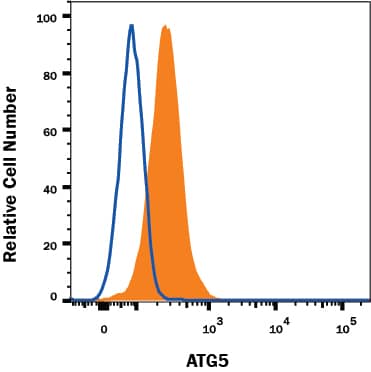Human/Mouse/Rat ATG5 Alexa Fluor® 647-conjugated Antibody
R&D Systems, part of Bio-Techne | Catalog # IC5294R


Key Product Details
Species Reactivity
Applications
Label
Antibody Source
Product Specifications
Immunogen
Asn99-Thr193
Accession # Q9H1Y0
Specificity
Clonality
Host
Isotype
Scientific Data Images for Human/Mouse/Rat ATG5 Alexa Fluor® 647-conjugated Antibody
Detection of ATG5 in HeLa Human Cell Line by Flow Cytometry.
HeLa human cervical epithelial carcinoma cell line was stained with Mouse Anti-Human/Mouse/Rat ATG5 Alexa Fluor® 647-conjugated Monoclonal Antibody (Catalog # IC5294R, filled histogram) or isotype control antibody (Catalog # IC0041R, open histogram). To facilitate intracellular staining, cells were fixed and permeabilized with FlowX FoxP3 Fixation & Permeabilization Buffer Kit (Catalog # FC012). View our protocol for Staining Intracellular Molecules.Applications for Human/Mouse/Rat ATG5 Alexa Fluor® 647-conjugated Antibody
Intracellular Staining by Flow Cytometry
Sample: HeLa human cervical epithelial carcinoma cell line fixed and permeabilized with FlowX FoxP3 Fixation & Permeabilization Buffer Kit (Catalog # FC012)
Formulation, Preparation, and Storage
Purification
Formulation
Shipping
Stability & Storage
- 12 months from date of receipt, 2 to 8 °C as supplied.
Background: ATG5
ATG5 (Autophagy-related Protein), also known as APG5L and Apoptosis-specific Protein, is a ubiquitous 32 kDa member of the ATG family of proteins. ATG5 exists as a covalent heterodimer with ATG12 through the creation of a Lys-Gly linkage. The ATG5:ATG12 heterodimer associates noncovalently with an ATG16 multimer to generate autophagosomes. Human ATG5 is 275 amino acids in length and contains N- and C-terminal ubiquitin-like domains (aa 15‑105 and 187‑275) separated by a helix-rich linker region that contains a dimerizing Lys at position 130. There are two potential alternate start sites at Met80 and Met173. Over aa 99‑193, human ATG5 is 97% aa identical to mouse ATG5.
Long Name
Alternate Names
Gene Symbol
UniProt
Additional ATG5 Products
Product Specific Notices for Human/Mouse/Rat ATG5 Alexa Fluor® 647-conjugated Antibody
This product is provided under an agreement between Life Technologies Corporation and R&D Systems, Inc, and the manufacture, use, sale or import of this product is subject to one or more US patents and corresponding non-US equivalents, owned by Life Technologies Corporation and its affiliates. The purchase of this product conveys to the buyer the non-transferable right to use the purchased amount of the product and components of the product only in research conducted by the buyer (whether the buyer is an academic or for-profit entity). The sale of this product is expressly conditioned on the buyer not using the product or its components (1) in manufacturing; (2) to provide a service, information, or data to an unaffiliated third party for payment; (3) for therapeutic, diagnostic or prophylactic purposes; (4) to resell, sell, or otherwise transfer this product or its components to any third party, or for any other commercial purpose. Life Technologies Corporation will not assert a claim against the buyer of the infringement of the above patents based on the manufacture, use or sale of a commercial product developed in research by the buyer in which this product or its components was employed, provided that neither this product nor any of its components was used in the manufacture of such product. For information on purchasing a license to this product for purposes other than research, contact Life Technologies Corporation, Cell Analysis Business Unit, Business Development, 29851 Willow Creek Road, Eugene, OR 97402, Tel: (541) 465-8300. Fax: (541) 335-0354.
For research use only